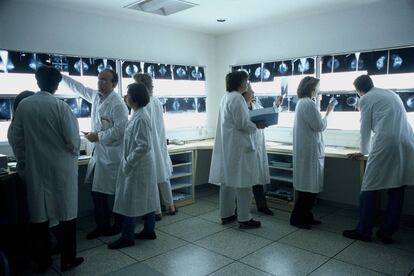Why the outlook for prostate cancer patients has never been so positive
Recent discoveries in risk reduction, screening, imaging and treatment have increased the chances men can beat the disease

The outlook for prostate cancer patients has never been so positive. That is the conclusion from the annual symposium of the Institute for Prostate Cancer Research held at the Fred Hutchinson Cancer Research Center in Seattle, Washington. At the day-long symposium, several prostate cancer experts provided their insights on the recent discoveries in prostate cancer risk reduction, screening, imaging and treatment. Here are four of the key takeaways.
1. Exercise can counter side effects of prostate cancer treatment
All cancer patients can benefit from exercise, including men with prostate cancer. In the last year, a growing body of evidence has shown that moderate exercise of any type is an excellent antidote to many unwanted side effects of androgen-deprivation therapy, or ADT. Many men can suffer muscle loss, fatigue and weight gain as a side effect of ADT therapy.
Exercise can improve a man¡¯s health and quality of life while they undergo ADT or other prostate cancer treatment
ADT is standard treatment for men with advanced prostate cancer and includes drugs such as Lupron and others that work using a similar mechanism, as well as Firmagon, a drug that works differently. ADT blocks the testicles¡¯ production of androgens, or the male hormones such as testosterone, that are likely to fuel prostate cancer growth. Removing this fuel source causes cancer to stop growing or to shrink. ADT therapy however, comes with serious side effects.
To combat these side effects, an increasing number of physicians recommend exercise. Exercise can improve a man¡¯s health and quality of life while they undergo ADT or other prostate cancer treatment. It can also improve muscle performance and a man¡¯s fat-to-lean ratio once treatment is completed, and maintain cardiovascular health and metabolism.
Muscle mass is better maintained when a man exercises ¨C this is important as loss of muscle mass is a normal byproduct of aging that can lead to falls and fractures, which is accelerated by ADT. Improving bone health is another benefit, particularly for men with prostate cancer that has metastasized to the bones. It can improve physical function and strength without causing bone pain or other side effects.
2. More treatment options available for erectile dysfunction after prostate cancer
Erectile dysfunction (ED) is a common issue that affects men after prostate cancer treatment. For a man to achieve an erection, there must be good blood flow to the penis. But cancer treatment such as surgery and radiation can harm the nerves, blood vessels, and tissues in the penis necessary for an erection.
The good news is that there are now many different options to help men continue to have a fulfilling sex life. A man experiencing ED should discuss these options with his doctor and work out a plan to improve the situation.
This could include lifestyle changes such as a healthier diet and exercise, and reducing blood pressure. If those changes do not help, drugs such as Viagra or Cialis could be considered. Therapies such as hand-operated vacuum pumps and medication that increases blood flow to the penis are another option, or a penile prosthesis could be used. In this case, a surgeon implants an inflatable device in the tissues of the penis and hides the attached pump inside the scrotum. The man is able to squeeze the hidden pump to cause an erection.
3. Better treatments for metastatic prostate cancer
Metastatic prostate cancer is cancer that has spread beyond the prostate gland. Men who are diagnosed with metastatic prostate cancer often have very little cancer outside of the prostate. Emerging research is pointing toward potential new treatment strategies to improve the health outcomes for men with this cancer.
There are now many different options to help men continue to have a fulfilling sex life
While surgery and radiation are unlikely to cure metastatic prostate cancer, studies in mice have indicated that controlling the growth of the primary tumor might help men with metastatic prostate cancer. Eliminating or greatly reducing the size of the primary tumor may disrupt a process called ¡°self-seeding.¡± This is where the metastatic tumor cells that move back to the primary tumor through the bloodstream release signals that make the cancer even more aggressive.
There are also a number of ongoing clinical trials in the United States and Europe that are testing treatment strategies specifically for men with newly diagnosed metastatic prostate cancer. These include large trials called STAMPED and PEACE1.
4. High-dose testosterone could treat prostate cancer
An area of active research is whether prostate cancer could be treated with high-dose testosterone. ADT therapy is a common therapy for treating prostate cancer but it doesn¡¯t work forever. Eventually prostate tumors learn how to get around the lack of testosterone and find a way to grow. But researchers have discovered that once a tumor has adapted to growing with little testosterone, high levels of testosterone can poison it.
This strategy is called ¡°bipolar androgen therapy.¡± Under this therapy, a patient alternates between ADT and high-dose testosterone therapy in order to stay one step ahead of the cancer so it doesn¡¯t get used to either a high- or low-testosterone environment. More research is being conducted on this theory, which could prove to be another alternative in the fight against prostate cancer.
Dr. Samadi is a board-certified urologic oncologist trained in open and traditional and laparoscopic surgery and is an expert in robotic prostate surgery at Lenox Hill Hospital. He is a medical correspondent for the Fox News Channel's Medical A-Team Learn more at roboticoncology.com. Visit Dr. Samadi's blog at SamadiMD.com. Follow Dr. Samadi on Twitter, Instagram, Pinterest and Facebook.
Tu suscripci¨®n se est¨¢ usando en otro dispositivo
?Quieres a?adir otro usuario a tu suscripci¨®n?
Si contin¨²as leyendo en este dispositivo, no se podr¨¢ leer en el otro.
FlechaTu suscripci¨®n se est¨¢ usando en otro dispositivo y solo puedes acceder a EL PA?S desde un dispositivo a la vez.
Si quieres compartir tu cuenta, cambia tu suscripci¨®n a la modalidad Premium, as¨ª podr¨¢s a?adir otro usuario. Cada uno acceder¨¢ con su propia cuenta de email, lo que os permitir¨¢ personalizar vuestra experiencia en EL PA?S.
En el caso de no saber qui¨¦n est¨¢ usando tu cuenta, te recomendamos cambiar tu contrase?a aqu¨ª.
Si decides continuar compartiendo tu cuenta, este mensaje se mostrar¨¢ en tu dispositivo y en el de la otra persona que est¨¢ usando tu cuenta de forma indefinida, afectando a tu experiencia de lectura. Puedes consultar aqu¨ª los t¨¦rminos y condiciones de la suscripci¨®n digital.


































































